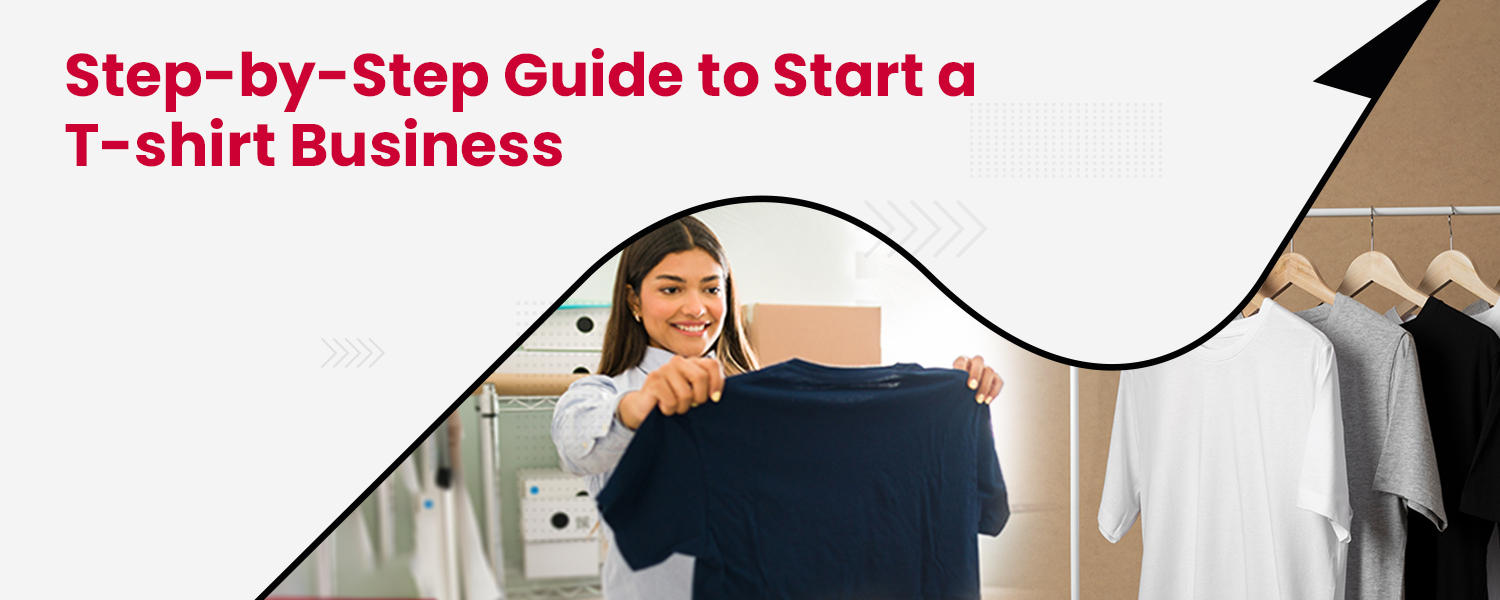A custom t-shirt is a staple piece of cloth in our wardrobes. It tells a story, makes a statement, and gives the wearer a sense of individuality. In fact, many consumers say they’re willing to pay more for a personalised product.
The global custom t-shirt printing market size reached USD 5.09 billion in 2022 and poised to grow at a CAGR of 11.27%. Therefore, if you’re an aspiring entrepreneur who has been toying with the idea and wants to become an online retailer, you’ve come to the right place.
This guide is designed with meticulous attention to detail, it aims to be your one-stop-shop for launching your t-shirt business and how to start an online clothing business. From selecting a niche and mastering the art of marketing, we’ve got you covered.
Step-by-Step Process to Start a t-shirt Business
1. Choose a Profitable Niche
If you’re stepping into the t-shirt business, you’ll quickly realise that it’s a huge market with cut throat competition. That’s why choosing a niche, a specialised segment of the market, is paramount. Targeting a niche helps you focus your marketing efforts and build a brand identity that resonates with a specific audience.
Use Google Trends to analyse the popularity of potential niches over time. Are they growing, stagnating, or declining? Your aim should be to target a niche that is steadily gaining traction.
2. Create a Business Plan
A well-crafted business plan serves as your roadmap, laying out the path from inception to growth, and mitigating risks along the way. The backbone of your business plan should comprise an ‘Executive Summary,’ a brief overview that encapsulates your business objectives and vision. Follow this with a ‘Business Objectives’ section, outlining short-term and long-term goals. A thorough ‘Market Analysis’ will give you and any potential investors insight into your chosen niche, its size, competitors, and target audience demographics.
3. Find a Supplier
When it comes to sourcing your t-shirts, you generally have three options: print-on-demand services, dropshipping, bulk manufacturing or private labeling. Print-on-demand and dropshipping are great for starting small, as they don’t require a large upfront investment. However, bulk manufacturing and private labeling gives you greater control over quality and pricing but demands a significant initial outlay.
If you’re fascinated by dropshipping, here is a full guide on how dropshipping works.
4. Create T-shirt Designs
The design phase is where your t-shirt business starts to take tangible shape, and the tools you use can make a significant difference. Adobe Illustrator and Photoshop are industry-standard options, providing a multitude of features tailored for design work. If you’re on a budget, free alternatives like GIMP or Canva are excellent choices that also offer a range of functionalities.
An effective design is often one that communicates its message in the simplest manner. The colours you choose can evoke emotions and even influence purchasing decisions. For instance, red is known to evoke passion and urgency, while blue can impart a sense of trust and calmness.
5. Create Mockups to Validate Your Designs
Mockups are digital or physical prototypes of your t-shirt that allow you to visualise the design in a real-world context. They serve as invaluable tools for internal assessment and for gathering preliminary customer feedback. It’s one thing to see your design on a computer screen and quite another to see it as it would appear on an actual product.
6. Set Up an Online T-shirt Store
You could have the best t-shirt designs in the world, but if visitors find your website cumbersome or confusing, they’ll leave. For quick and easy setup, eCommerce platforms like Shopify offer built-in features such as payment gateways and a variety of customisable templates but custom websites provide the highest degree of control.
While setting up your online store, make sure it is user friendly because a smooth, intuitive user experience is crucial for online retail success. User experience (UX) considerations include site speed, ease of navigation, and mobile-friendliness.
7. Price Your T-shirts
Determining the right price for your t-shirts is like balancing a complex equation involving cost, consumer perception, and market dynamics. There are multiple strategies to consider:
Cost-plus Pricing: This straightforward strategy involves adding a markup percentage to your production cost. While this ensures you cover all costs and make a profit, it might not always align with market conditions or customer expectations.
Competitive Pricing: Here, you price your products based on what your competitors are charging. It’s a fast-track approach to match or beat the market.
Value-based Pricing: In this approach, pricing is determined by the perceived value of the product to the customer rather than just the cost of production or market trends.
8. Make Your T-shirt Business Legal
Registering your business not only makes you official but also affords you legal protection and credibility. It is a non-negotiable step in establishing your t-shirt company. The type of business structure you choose—be it Sole Proprietor, LLC, or Corporation—will have significant implications on taxation, liability, and governance. Whether it’s for applying for loans, opening business bank accounts, or negotiating contracts with suppliers, a registered business is a minimum requirement.
9. Market Your Product
Marketing is the lifeblood of your t-shirt brand or any online business. Organic strategies such as SEO optimisation for your website, content marketing, and social media presence are slow burns that yield long-term results. These are non-negotiable in today’s digital age and work to build brand trust and community.
10. Analyse Your Performance
What gets measured gets managed. Constant performance tracking allows you to make data-driven decisions that align with your business goals. Metrics such as customer acquisition cost, customer lifetime value, conversion rates, and average order size are essential Key Performance Indicators (KPIs) that can guide your business strategy.
Use Google Analytics for an in-depth understanding of your website traffic and consumer behaviour. Many eCommerce platforms also offer built-in analytics tools that can help you track sales, returns, and customer engagement metrics.
Here are Some Tips to Make a Successful T-shirt Brand
- Crafting a compelling story around your apparel brand can significantly elevate your connection with your target audience.
- Consistency in visual elements and messaging amplifies your brand identity. From your website layout to the packaging of your t-shirts, everything should echo the ethos of your brand.
- Use videos, blog posts, and interactive social media posts to articulate your brand’s story. Each medium offers a different facet of your brand, making it richer and more engaging.
- Encourage satisfied customers to share photos of themselves wearing your t-shirts.
- Utilise customer reviews and testimonials and place them strategically on your product pages and social media channels.
- Partner with social media influencers who align with your brand’s values.
- Use CRM systems, chatbots, and AI to streamline your customer service operations.
Conclusion
So there you have it—you’ve the blueprint to launch your very own eCommerce business. Following what you’ve learnt today will bring you from 0 to 1, will give you your first order. The real business starts from here, you get your first order and now you’ve to deliver it quickly, safely, and efficiently. That’s where logistics service comes in. A logistics service helps you deliver the products at customer’s doorsteps. To find the best logistics service, head to NimbusPost and get courier recommendations from experts. Our cutting-edge platform enables bulk shipment, real-time tracking, quick COD remittance, and more features like this.
FAQs
Is the t-shirt business profitable?
Yes, the t-shirt business can be highly profitable. This is a thriving industry with substantial opportunity for profitability. With the right business plan, niche selection, and marketing strategies, entrepreneurs can tap into this growing market to achieve financial success.
What materials do I need to start a T-shirt business?
To start a t-shirt business, you’ll need the following essential materials:
- Printers: Invest in a high-quality DTG (Direct to Garment) or screen printer for detailed and vibrant designs.
- Computers: A robust computer system is crucial for design work and business operations.
- Graphic Designing Tools: Software like Adobe Illustrator or CorelDRAW is essential for creating intricate and original designs.
- Transfer Paper: Necessary for transferring your designs onto the t-shirts, especially if you’re using inkjet or laser printers.
- Heat Press: A heat press machine is used to permanently apply the design onto the t-shirt fabric.
- Cutter: A cutting machine helps in shaping the designs precisely before they’re transferred onto the t-shirts.
With these materials in hand, you’ll be well-equipped to launch your own t-shirt business.
How much does it cost to produce 1 t-shirt?
The cost to produce one standard, basic cotton men’s t-shirt in India ranges from $2 to $5 per unit. In terms of local currency, the basic cost for a 100% cotton t-shirt is approximately 220 Rupees. This cost encompasses the fabric, stitching, and packing expenses.
What tools do I need to start my t-shirt business?
Here are some tools you might need to start a t-shirt business:
Printing tools: Heat press, printers, cutter, emulsion, transfer paper, inks, and dryer
Screen printing: A popular method for transferring designs to tees. This style of printing is high-quality for complex designs or designs with many colors.
Direct to garment printing: Operates like an ink-jet printer and can produce full-color images with accuracy.
Digital heat transfers: Involves printing the design out and then using the heat press to transfer it onto the shirt.



